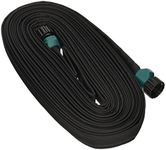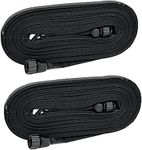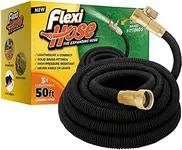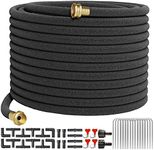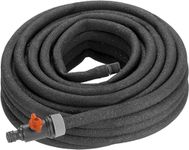Buying Guide for the Best Soaker Hoses
Choosing the right soaker hose can make watering your garden or landscaping much more efficient and hassle-free. Soaker hoses are designed to slowly release water along their length, delivering moisture directly to the roots of your plants. When picking a soaker hose, it's important to consider your garden's size, the types of plants you have, and how you plan to lay out the hose. Understanding the key features will help you select a hose that meets your needs and ensures healthy, well-watered plants.LengthThe length of a soaker hose determines how much area you can cover in a single run. Hoses typically come in lengths ranging from 25 to 100 feet. Shorter hoses are easier to manage and are ideal for small gardens or raised beds, while longer hoses are better for larger areas or rows of plants. To choose the right length, measure the area you want to water and consider if you need to snake the hose around multiple beds or rows. Remember, longer hoses may have less even water distribution, so sometimes using multiple shorter hoses is more effective.
DiameterSoaker hoses usually come in diameters like 1/4 inch, 1/2 inch, and 5/8 inch. The diameter affects how much water the hose can deliver and how flexible it is. Smaller diameters are great for tight spaces or container gardens, while larger diameters are better for covering bigger areas and delivering more water. If you have a large garden or need to water many plants at once, a wider hose is usually more efficient. For smaller or more delicate setups, a thinner hose is easier to handle and position.
MaterialSoaker hoses are commonly made from recycled rubber, polyurethane, or vinyl. Rubber hoses are durable and flexible, making them a popular choice for most gardens. Polyurethane hoses are lightweight and less likely to kink, while vinyl hoses are often more affordable but may not last as long. If you need a hose that will withstand sun exposure and frequent use, look for one made from high-quality rubber. For lighter, occasional use, polyurethane or vinyl may be sufficient.
PorosityPorosity refers to how much water the hose releases along its length. Some hoses are designed to release water more quickly, while others provide a slow, steady drip. High-porosity hoses are good for sandy soils or plants that need more water, while low-porosity hoses are better for clay soils or plants that prefer less moisture. Consider your soil type and the water needs of your plants when choosing the porosity level.
FlexibilityFlexibility determines how easily you can lay the hose around curves, corners, or tight spaces in your garden. More flexible hoses are easier to position and can be snaked around plants or beds, while stiffer hoses may be harder to maneuver but can hold a straight line better. If your garden has lots of curves or irregular shapes, a highly flexible hose will be easier to work with. For straight rows or simple layouts, flexibility is less critical.
UV ResistanceUV resistance is a feature that helps the hose withstand damage from sunlight. Hoses with good UV resistance will last longer when left out in the sun, while those without it may crack or degrade more quickly. If you plan to leave your soaker hose in place throughout the growing season, look for one with UV protection to ensure it remains effective and durable.
